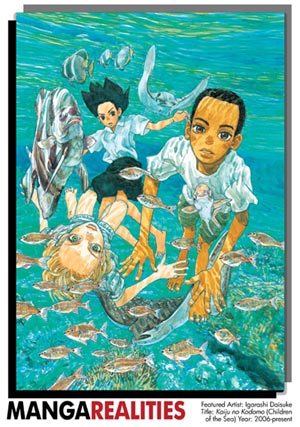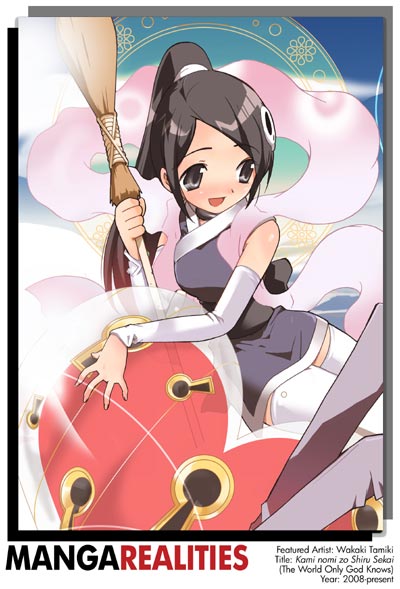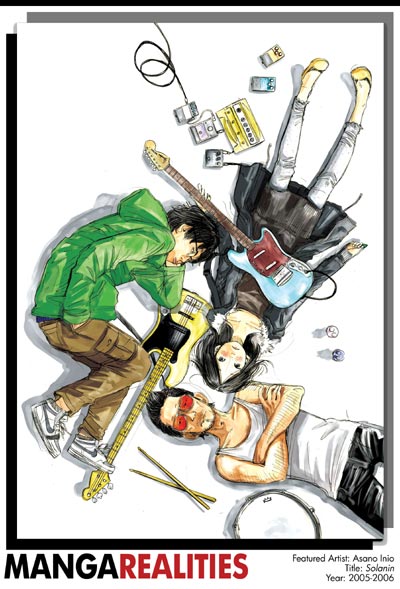Up until the early 1990s, before video games took over, Japanese manga (comics) was a cheap source of printed entertainment for harried subway commuters in Japan in between their embarkation and disembarkation points. Manga copies cost so little that readers usually bought them in one station, read them on board trains running at least 70 kph, and left them in the open overhead compartments of the coaches before alighting at their destination. Manga comics were at least two inches thick and quite heavy; comic books in the Philippines look like pocketbooks compared to manga. Manga fans usually pick up copies intentionally left behind by fellow commuters in train coaches or placed on top of benches at the stations, in anticipation that they will be re-read. As a young foreign student in central Tokyo on a tight budget back then, I learned a lot of kanji (written Japanese characters) on board trains while skimming through recycled manga comics.

The traditional concept of manga as printed one-dimensional comics intended to be read in solitary enjoyment was dramatically turned upside down by the traveling “Manga Realities: Exploring the Art of Japanese Comics Today." The exhibit, which is sponsored by the Japan Foundation-Manila Office and the Contemporary Art Center-Art Tower Mito in Japan, opened last Aug. 15 at the Ayala Museum. First mounted at the famous Art Tower Mito in the Ibaraki prefecture, the traveling exhibit is an experiential and three-dimensional interpretation of the world by nine manga artists featuring their works in the last decade:
Tomoko Ninomiya’s Nodame Cantabile Harold Sakuishi’s BECK: Mongolian Chop Squad Asano Inio’s Solanin Anno Moyoco’s Sugar Sugar Rune Igarashi Daisuke’s Children of the Sea Kuramochi Fusako’s Five Minutes from the Station Kyo Machiko’s Sennen-Gaho (One Thousand Years Diary) Matsumoto Taiyo’s No. 5 Wakaki Tamiki’s The World God Only Knows Exhibition curator Mizuki Takahashi said contemporary Japanese manga have been influenced by American films, European comics, the Japanese traditional painting style of
maki-e, and the development of the Internet. In a speech opening the exhibition, Takahashi said at least 100 titles of Japanese comics are published in Japan every year. Thus, the nine artists and their works comprising the exhibition are only “a tiny part of the world of Japanese comics but we tried to show the diversity of Japanese comics through them," Takahashi said. “Dissatisfied with the magazine format alone, in recent years, manga have been translated into a wide range of other media including anime, movies, and games. Moreover, while manga artists once created their work with simple tools like pens and paper, it has become increasingly common to use computers to draw pictures," Takahashi explained in her exhibition notes. Matsumoto’s
Number Five is a story of a hero in search of an identity in the post-Cold War setting, where categorical political ideologies and sharply divided concepts of right and wrong have collapsed.
Wakaki’s
The World God Only Knows, strongly influenced by animation and games about role-playing, gives a critical look on the continuum of “real’ and “virtual" spheres. On the other hand, Igarashi has refused to follow the move of manga artists to computer graphics and continues to draw by hand. His
Children of the Sea tackles the universal tale of human history and life. It also continues the manga post-war tradition of “story manga" or the rough equivalent of literary style. Anno’s
Sugar Sugar Rune is an attempt to revisit the concept of manga as a medium to convey the message of hopes and dreams and of ethical ways of living. Sakuishi’s
BECK is about a young boy named Koyuki who meets another boy named Minami Ryusuke. He encourages him to start a rock band together with his friends, leading him to explore his talent as a vocalist. Similarly, Ninomiya’s
Nodame Cantabile revolves around a gifted pianist who is unaware of her talents, Chiaki who aspires to become a world renowned conductor, and their relationship with other musicians. Both
BECK and
Nodame are powerful symbols of the crossover in the media of television, film, and music.
Asano’s
Solanin depicts Japan’s present-day youth who are awash with material wealth but at the same time bereft of dreams, hopes, and aspirations for the future. Kyo’s
Sennen Gaho, published as an online blog, focuses on random moments in the daily life of a high school boy and girl with touches of fantasy. Kuramochi’s
Five Minutes from the Station narrates numerous “small stories" of people inhabiting a city. Hideki Toyoshima, exhibition designer of Manga Realities who runs his own gm projects art company, said traditional manga exhibits show the original drawings of artists. “In this exhibition, we tried to explore the possibility of three-dimensional manga world in an exhibition setting. It was a hard challenge for us to do this. There were a lot of conversations with the manga artists’ team, and finally we came up with this exhibit, a sharing of the manga experience in a public space with other people," Toyoshima said. Shuji Takatori, Japan Foundation-Manila Office director, said manga was once simply a source for children’s amusement or a sub-culture. “Public perception of manga has been changed in recent years. Manga is now enjoyed by young and adult alike. Manga is regarded as a leading medium of Japanese culture that attracts global attention. This exhibition creates the world of manga through installation, sounds, and video," he added. In the Philippines, Ayala Foundation president Victoria Garchitorena said Japanese manga and anime capture the enthusiasm of Filipinos mostly aged 18-35. “We want to attract this younger group to the museum so that they too get to a better understanding and appreciation of our rich history and tradition," she said. She added that special exhibitions such as the Manga Realities complement the regular displays at the Ayala Museum, which is a co-organizer of the event. From the Art Tower Mito, Manga Realities has traveled to Artsonje Center in Seoul and to Vietnam Fine Arts Museum in Hanoi. The Philippines is its final destination, running until Oct. 2 at the Ayala Museum’s Ground Floor Gallery and at the Glass Lane and Luna and Amorsolo Rooms at the 3rd Floor. –
YA, GMA News The Ayala Museum is located along Makati Avenue corner De la Rosa Street, Greenbelt Park, Makati. For inquiries, call 757.7117 up to 21 local 29 or 35 or visit www.ayalamuseum.org for its schedule of activities. All photos of artworks courtesy of Japan Foundation Manila Office. Editor's note: This article was revised slightly to correct the error pointed out by a reader in the comments section below. Reader feedback is much appreciated, thanks.






